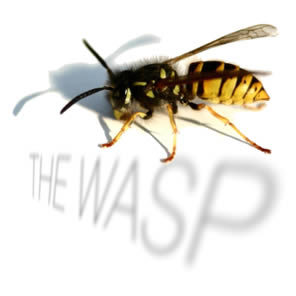




The Wasp
(flying insects)
Tree wasps,
Dolichovespula spp
Key features
Adult worker wasps have the characteristic black and
yellow patterning on the abdomen and are between
15 - 20 mm long. They have a black head and thorax.
The fore and hind wings are held together by a row of minute hooks giving the appearance of
only one wing per side of the wasp. The wings are heavily veined.
Biology
The wasps are colonial insects living in social groups.
Each colony is established in the spring by an over wintering queen which makes a smaller starter
nest from paper made by itself by mixing wood and saliva.
The colony grows throughout the summer and the nest with it. Many thousand individuals are often to be found associated with each nest, with the workers feeding on nectar, sweet materials and at certain times insect larvae and other animal pieces.
The colony develops males towards the end of the summer to mate with the presumptive queens which when mated over winter start a new colony the following year.
Distribution
Worldwide. Dolichovespula norvegica, the Norwegian wasp, and Dolichovespula sylvestris, the tree wasp, Dolichovespula spp usually produce grey aerial nests, which have a regular laminar construction. They may be suspended from trees, nest boxes, bee hives, rafters and dormer windows. If nests are formed underground, the envelope is always visible.
Significance
The wasps can cause alarm when present in large numbers and if the nest is in a place where the individuals from it interfere with humans they can inflict painful and sometimes dangerous stings.
Control
The most unusual application of treatment for wasps is an insecticidal dust to the nest, around and into the entrance. Liquid surface sprays can also be used. For control of adult wasps, space sprays can be used indoors or surface sprays can be applied in localized areas.

